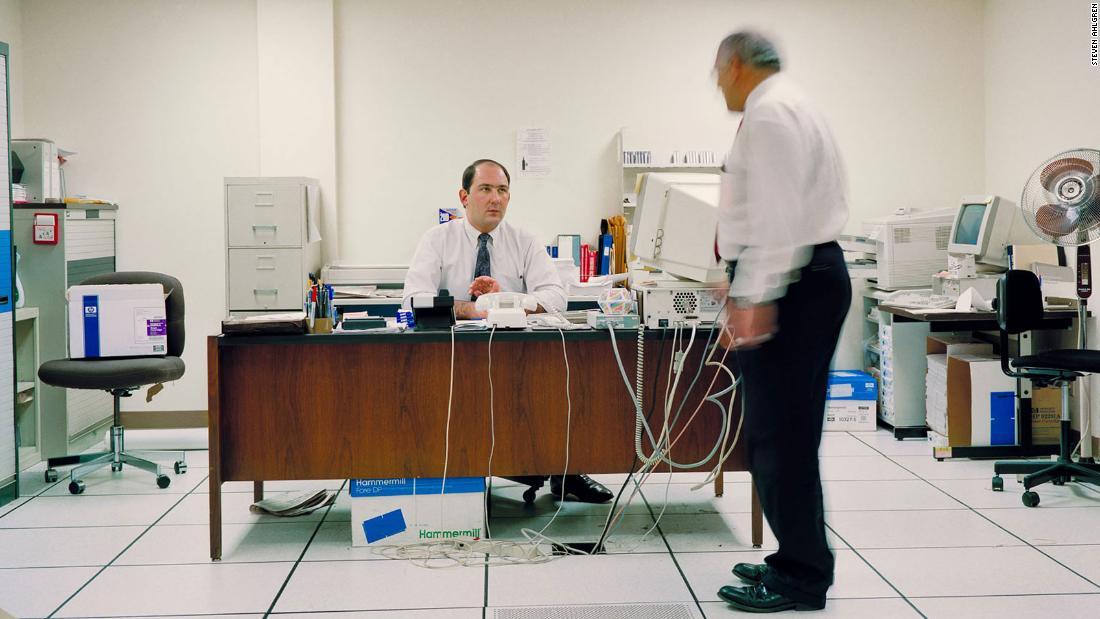Wires, watercoolers and off-white walls: A portrait of ’90s offices
So, at a time when many are questioning whether we need offices at all, photographer Steven Ahlgren’s archival images of American workplaces are a reminder of a not-too-distant past.
Shot over the course of 11 years, the pictures offer a glimpse of corporate life in the 1990s and early 2000s. Ahlgren used gigs photographing business networking events to secure invites to legal and accounting firms, government offices and commercial banks.
While there, he captured offices equipped with boxy computers, fax machines and labyrinths of cables that speak to the technological shifts that have occurred in the past two decades. But the photographer’s images are also curiously intimate, with employees seen staring at paperwork, speaking into desk phones or attending meetings under fluorescent tube lights.
“I would say to them, ‘Just do whatever you normally do, and I’m going to watch and take some pictures,'” he said via video call from his home in Media, Pennsylvania, adding: “I would just sit and just watch.”

This photograph of a man at a commercial bank was “as close to a self-portrait that I’ve ever made,” Ahlgren said. Credit: Steven Ahlgren
Ahlgren could, after all, relate to his subjects: Before becoming a professional photographer, he had worked as a banker. In particular, he saw something of himself in the image of a young man standing over a Xerox machine with his hands buried deep in his pockets, seemingly lost in thought.
“It’s as close to a self-portrait that I’ve ever made,” Ahlgren said. “I think I looked exactly like that when I was working at the bank.
“I had some bitterness from the years I spent in banking, and I felt it was wasted time,” he added. “So, when I started (the project) I thought, ‘Here are people wasting their lives, just like I was.’ But then I began to really empathize with them. They may have loved their work.”
Indeed, viewed through today’s lens, the ostensibly drab scenes offer a compelling case for the death of offices as we knew them. Seas of off-white walls and filing cabinets are only rarely interrupted by flashes of color, whether from playful neckties, cubicle decorations or framed artworks.
But for many people, the images will spark a sense of nostalgia. Moreover, hidden within the beige are depictions of success and fulfilment. Ahlgren offered as example an image of two stern-faced women sat beneath almost a dozen portraits of men at a commercial bank — amid the dated conference room interiors is, according to the photographer, a story of women succeeding in what he called the “old boys’ network” of corporate America.
“It’s whatever you, the viewer, takes from it,” he said of his series. “Because you’re bringing to it memories that relate to whatever you thought about that particular time.”

A watercooler moment at an insurance company. Credit: Steven Ahlgren
Creating tension
Ahlgren’s corporate past wasn’t the only source of inspiration. He was also influenced by Edward Hopper’s oil painting “Office at Night.” Depicting a suited man behind his desk and a young woman at a filing cabinet besides him, the 1940 work invites viewers to speculate on the possible relationship between the two.
In the 1980s, Ahlgren — then increasingly bored by his work as a banker in Minneapolis, Minnesota — would make regular trips to the nearby Walker Art Center, where the painting is usually housed.

Edward Hopper’s “Office at Night” on display in Paris in 2012. Credit: Francois Mori/AP
“It just kind of clawed at me, and I kept coming back to it,” he said of Hopper’s artwork. “What I got from it was this idea that you could have a very plain, pedestrian, everyday situation — and it’s hard to think of anything more like that than the average office — and make it something dramatic. To fill the narrative tension in some way.”
Ahlgren’s use of Hopper-esque lighting, which spotlights solitary subjects and casts evocative geometric shadows, was not entirely by design: The photographer never brought his own lights, so the clinical illumination was always “whatever was there” at any given office. But the painter’s influence is also clear in the quiet intensity and poetic ambiguity of the shots, with employees often captured alone or interacting with unseen figures and obscured faces.

Ahlgren, who intentionally made himself as inconspicuous and “boring” as possible, was sometimes invited to attend meetings. Credit: Steven Ahlgren
Yet, Ahlgren retains fond memories of his old office in Minneapolis — a “pretty space” populated with paintings acquired by his former company’s art-loving director, he recalled. And while the pandemic presented an ideal time to revisit the series, critiquing corporate life “was never intention of the pictures whatsoever.”
Nor is he convinced that the “whole office dilemma” brought about by the pandemic spells the end of physical workplaces.
“I know I’d find it hard working from home,” Ahlgren said. “I watched my daughters, who are in college, and my wife work from home. It would drive me crazy.”
For all the latest world News Click Here

